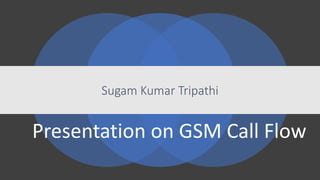
GSM CALL FLOW
- 1. Sugam Kumar Tripathi Presentation on GSM Call Flow
- 3. Frequency Correction Channel (FCCH) •Downlink Channel •BTS: Transmits a carrier frequency (Pure sine wave of 67.7 KHz) This Solve 2 purpose : a> Make sure that this is BCCH Carrier b> To allow the MS to synchronize to the frequency •MS: After Switch on MS Scan for this channel, since it has no information to which frequency to use. FCCH carrier enables a mobile to tune its frequency to that being broadcast by the BTS.
- 4. Broadcast Control Channel (BCCH) •Downlink Channels •BCCH contains the detailed Network and cell specific information such as : •Frequency used by Cell and its Neighboring cells. •Frequency HSN •Paging Groups •LAI •Max output power allowed in the cell
- 5. Random Access Channel (RACH) • RACH is transmitted Uplink only •When mobile is paged , it replies on RACH requesting a signaling channel. •RACH can also used if the MS wants to make a contact the NW/ Originating calls
- 6. Stand Alone Dedicated Control Channel (SDCCH • SDCCH is bi-directional Channel •System Signaling •Call Setup •Authentication •Location Update •Assignment of Traffic channels and •Transmission of Short messages
- 9. THANK YOU • TUTORIAL POINTS • WIKIPEDIA • MIT EDU
- 10. MOBILE STATION • The MS consists of the physical equipment, such as the radio transceiver, display and digital signal processors, and the SIM card. It provides the air interface to the user in GSM networks. As such, other services are also provided, which include: • Voice teleservices • Data bearer services • The features' supplementary services
- 11. The Base Transceiver Station (BTS) • The BTS houses the radio transceivers that define a cell and handles the radio link protocols with the MS. In a large urban area, a large number of BTSs may be deployed • The BTS corresponds to the transceivers and antennas used in each cell of the network. A BTS is usually placed in the center of a cell. Its transmitting power defines the size of a cell. Each BTS has between 1 and 16 transceivers, depending on the density of users in the cell. Each BTS serves as a single cell. It also includes the following functions: • Encoding, encrypting, multiplexing, modulating, and feeding the RF signals to the antenna • Transcoding and rate adaptation • Time and frequency synchronizing • Voice through full- or half-rate services • Decoding, decrypting, and equalizing received signals • Random access detection • Timing advances • Uplink channel measurements
- 12. The Base Station Controller (BSC) • The BSC manages the radio resources for one or more BTSs. It handles radio channel setup, frequency hopping, and handovers. The BSC is the connection between the mobile and the MSC. The BSC also translates the 13 Kbps voice channel used over the radio link to the standard 64 Kbps channel used by the Public Switched Telephone Network (PSDN) or ISDN. • It assigns and releases frequencies and time slots for the MS. The BSC also handles intercell handover. It controls the power transmission of the BSS and MS in its area. The function of the BSC is to allocate the necessary time slots between the BTS and the MSC. It is a switching device that handles the radio resources. Additional functions include: • Control of frequency hopping • Performing traffic concentration to reduce the number of lines from the MSC • Providing an interface to the Operations and Maintenance Center for the BSS • Reallocation of frequencies among BTSs • Time and frequency synchronization • Power management • Time-delay measurements of received signals from the MS
- 13. Mobile Switching Center The central component of the Network Subsystem is the MSC. The MSC performs the switching of calls between the mobile and other fixed or mobile network users, as well as the management of mobile services such as registration, authentication, location updating, handovers, and call routing to a roaming subscriber. It also performs such functions as toll ticketing, network interfacing, common channel signaling, and others. Every MSC is identified by a unique ID.
- 14. Home Location Register (HLR) • The HLR is a database used for storage and management of subscriptions. The HLR is considered the most important database, as it stores permanent data about subscribers, including a subscriber's service profile, location information, and activity status. When an individual buys a subscription in the form of SIM, then all the information about this subscription is registered in the HLR of that operator.
- 15. Visitor Location Register (VLR) • The VLR is a database that contains temporary information about subscribers that is needed by the MSC in order to service visiting subscribers. The VLR is always integrated with the MSC. When a mobile station roams into a new MSC area, the VLR connected to that MSC will request data about the mobile station from the HLR. Later, if the mobile station makes a call, the VLR will have the information needed for call setup without having to interrogate the HLR each time.
- 16. Equipment Identity Register • The Equipment Identity Register (EIR) is a database that contains a list of all valid mobile equipment on the network, where its International Mobile Equipment Identity (IMEI) identifies each MS. An IMEI is marked as invalid if it has been reported stolen or is not type approved.
- 17. Authentication Center (AUC) The Authentication Center is a protected database that stores a copy of the secret key stored in each subscriber's SIM card, which is used for authentication and ciphering of the radio channel. The AUC protects network operators from different types of fraud found in today's cellular world.